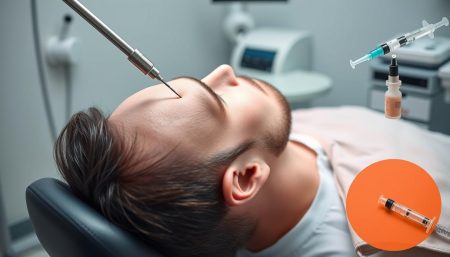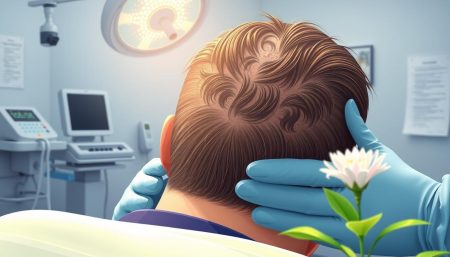Gone are the days when patchy or thinning beards were a big worry. Now, a well-groomed beard is seen as a sign of distinction. Beard hair transplant techniques have improved, letting men get the full, robust beard they want. This is for those who want to improve their facial hair due to genetics, past injuries, or medical conditions.
The latest facial hair transplant methods offer a lasting solution, unlike topical treatments. They also blend well with natural hair growth. With high demand, board-certified surgeons in the U.S. have perfected their craft. A beard hair transplant can now give you a beard that matches your unique features and style.
What is a Beard Hair Transplant?
A beard hair transplant is a cosmetic procedure that makes your facial hair look fuller. It’s perfect for those with patchy growth or wanting a more defined beard. This could be the answer you’ve been looking for.
Definition and Overview
Beard hair grafting moves hair follicles from the scalp to your beard. It uses strong scalp hair to make your beard look natural. It’s great for people who can’t grow a thick beard on their own.
How It Works
The first step is picking a donor area with healthy hair. Then, the donor hairs are carefully taken and placed in your beard. This method is done with great care to match your natural beard growth.
Every step is done with precision to keep the hair follicles alive. This is key for a successful beard transplant. The aim is to create a beard that looks natural and full.
Benefits of Beard Hair Transplants
A beard hair transplant can make your face look better and feel better. It’s a big change that can make you feel more confident and look more mature.
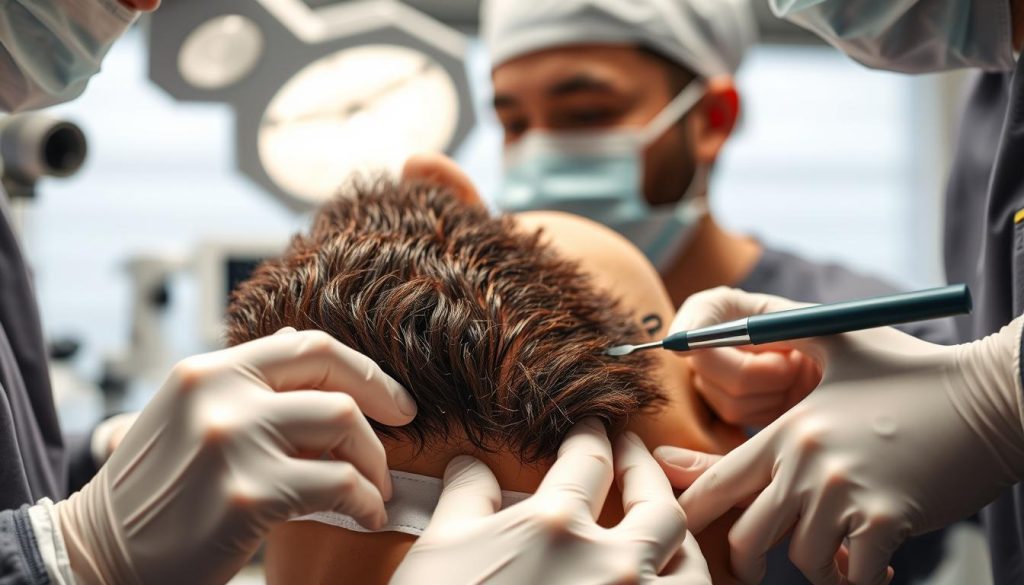
Studies show that a neat beard makes you seem older, wiser, and more professional. Fixing thin or uneven beards can really boost your self-confidence and how you see yourself.
Improved Facial Aesthetics
One big plus of a beard transplant is how it makes your face look. It helps men with sparse or uneven hair to get a full, natural-looking beard.
Boost in Confidence
Many people get a hair transplant to feel better about themselves. Looking good and feeling like your best self can make you happier and more confident.
New hair restoration methods make it easier to get the beard you want. They help fix flaws that might have made you feel less confident.
| Aspect | Before | After |
|---|---|---|
| Beard Density | Low | High |
| Facial Symmetry | Unbalanced | Enhanced |
| Confidence Level | Low | Significantly Improved |
Who is a Good Candidate?
Understanding candidate suitability for hair transplant is key when thinking about a beard hair transplant. The best candidates have enough healthy donor hair, usually from the back of the scalp. They also need to have realistic hopes about the transplant’s success.
It’s not just about having thin or patchy facial hair. It’s also about the health of your existing hair follicles and your overall health.
Things like your hair’s natural characteristics and your skin type matter a lot. Let’s look at what makes someone a good candidate for a beard hair transplant.
Ideal Age Range
The ideal age range for a beard hair transplant is between 25 and 50 years. This age range is best because younger people might not have lost as much hair yet. Older people might have less hair quality or not enough donor hair because of aging.
Skin and Hair Type Considerations
When deciding if someone is a good candidate for a hair transplant, skin and hair type are very important. People with strong, elastic skin and lots of healthy donor hair do best. The color and texture of your hair can also impact how natural the transplant looks.
Different Techniques for Beard Hair Transplants
Looking into the best beard hair transplant methods can really help get a fuller, more natural beard. Follicular Unit Extraction (FUE) and Direct Hair Implantation (DHI) are top choices for facial hair growth.
Follicular Unit Extraction (FUE)
FUE for beard takes hair follicles from the scalp’s back, using a special tool. It’s loved for its small scars and great results. It lets the surgeon pick hairs that look good in the beard, making it look better.
Direct Hair Implantation (DHI)
DHI is another top method. It uses a special tool to take out follicles and put them in the beard right away. This might help more hairs survive. It’s known for its precision, which is key for a natural, full beard.
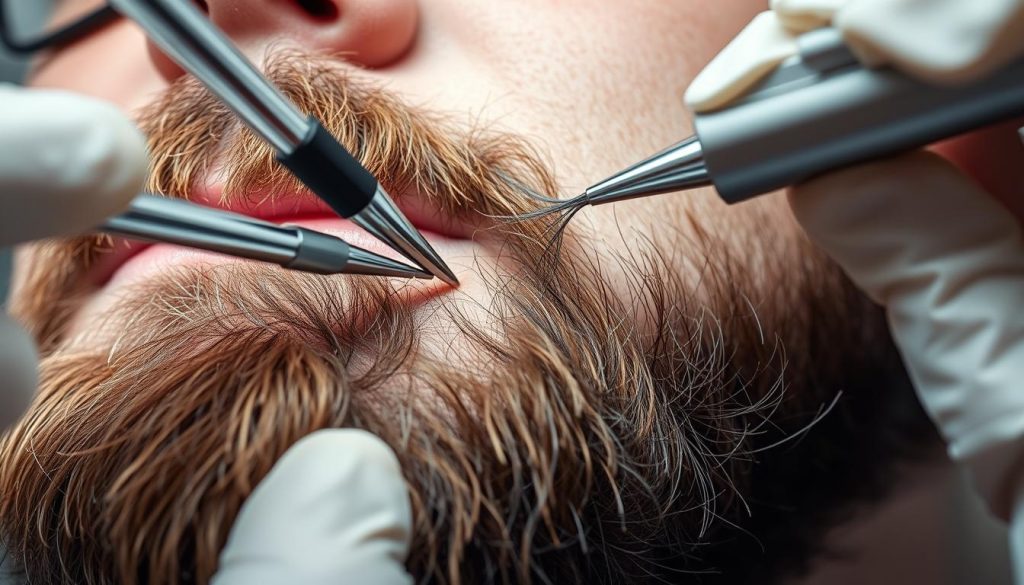
| Technique | Scarring | Healing Time | Graft Survival Rate |
|---|---|---|---|
| Follicular Unit Extraction (FUE) | Minimal | 1-2 weeks | 90-95% |
| Direct Hair Implantation (DHI) | None | 1 week | 95-98% |
Choosing between FUE and other methods depends on what you need and your hair. Both FUE and other techniques can solve different hair problems.
The Beard Hair Transplant Procedure
A beard hair transplant is a key solution for those wanting to boost their facial hair. It involves several important steps, starting with a detailed consultation and ending with careful surgery. Knowing about beard transplant surgery and the beard hair grafting procedure helps candidates understand what to expect.
Consultation Process
The first step is a detailed consultation. A specialist will look at your facial hair’s density, growth, and your beauty goals. This is key to creating a plan that fits your needs.
Steps of the Surgery
The surgery part is detailed and needs skill and precision. Here are the main steps:
- Harvesting hair follicles from the back of the scalp, where hair grows well.
- Preparing the follicles and keeping them alive in a solution before transplanting.
- Making small cuts in the face, following the natural beard growth direction.
- Placing the follicles in the beard area for a natural look.
The aim of beard hair grafting procedure is to fill in thin spots and shape a better beard. This improves your facial look.
After the surgery, caring for the grafts is vital for healing and success. Patients must follow their surgeon’s advice closely to ensure the grafts thrive.
Recovery Timeline
Knowing how long it takes to recover from a beard hair transplant is key for the best results. This part talks about the important steps in caring for yourself after surgery. It covers both the first steps and the long-term care needed for a successful recovery.
Immediate Post-Op Care
Right after the surgery, it’s important to manage any pain and reduce swelling. The clinic will give you detailed instructions on how to care for yourself. These include:
- Gently clean the area where the hair was transplanted without rubbing or using strong shampoos.
- Use ice packs indirectly to help reduce swelling in your jaw and cheeks.
- Stay away from activities that make your face blood flow more, like bending or lifting heavy things.
- Make sure you sleep in a way that doesn’t put pressure on the new hair follicles.
Long-Term Healing Process
The healing process over time focuses on the body accepting the new hair follicles. Important long-term care steps include:
- Eat a healthy diet full of vitamins and minerals to help your hair grow.
- Stay out of direct sunlight and use sunblock as recommended by your doctor to protect the new hair.
- Go back to your surgeon for check-ups to see how your recovery is going.
- Don’t smoke or drink alcohol because they can slow down healing.
Following these steps can help you heal faster and get a fuller, natural-looking beard from the transplant.
Possible Side Effects and Risks
While beard hair transplant side effects are usually mild, it’s key to know both common and rare risks. Making informed choices is crucial in cosmetic procedures like this.
Common Side Effects
Most people will see redness, itching, or swelling after the procedure. These signs are normal and usually go away in a few days. But, it’s vital to watch them to catch any serious problems early.
Rare Complications
Less common but serious risks include infections or hair growth issues. Choosing an experienced surgeon can lower these risks.
To learn more about beard transplant side effects, read detailed accounts and studies. They offer deeper insights into what to expect and how to prepare well.
| Side Effect | Frequency | Description |
|---|---|---|
| Redness | Common | Temporary redness at implantation sites |
| Itching | Common | Mild to moderate itching as healing begins |
| Swelling | Common | Localized swelling around the treated areas |
| Infection | Rare | Potential infection demanding medical attention |
| Unsatisfactory Growth | Rare | Patchy or uneven beard growth post-transplant |
Cost of Beard Hair Transplants
Understanding the beard transplant cost is key for those thinking about it. It’s a way to improve your look. The cost varies based on several important factors.
Average Price Range in the U.S.
In the U.S., a beard hair transplant usually costs between $5,000 and $15,000. But, the beard hair transplant expenses can go higher. This depends on your specific needs and health.
Factors Influencing Cost
Several things affect the cost of a beard hair transplant. The size of the area, the transplant method, and the surgeon’s skill are important. Also, where you live can change the price.
| Factor | Impact on Cost |
|---|---|
| Transplant Area | Larger areas require more grafts, increasing the cost. |
| Technique Used | FUE and DHI, being advanced techniques, tend to be pricier than traditional methods. |
| Surgeon’s Expertise | Highly experienced surgeons typically charge more due to their enhanced skills and higher demand. |
| Geographical Location | Clinics in metropolitan areas often have higher prices compared to those in smaller towns. |
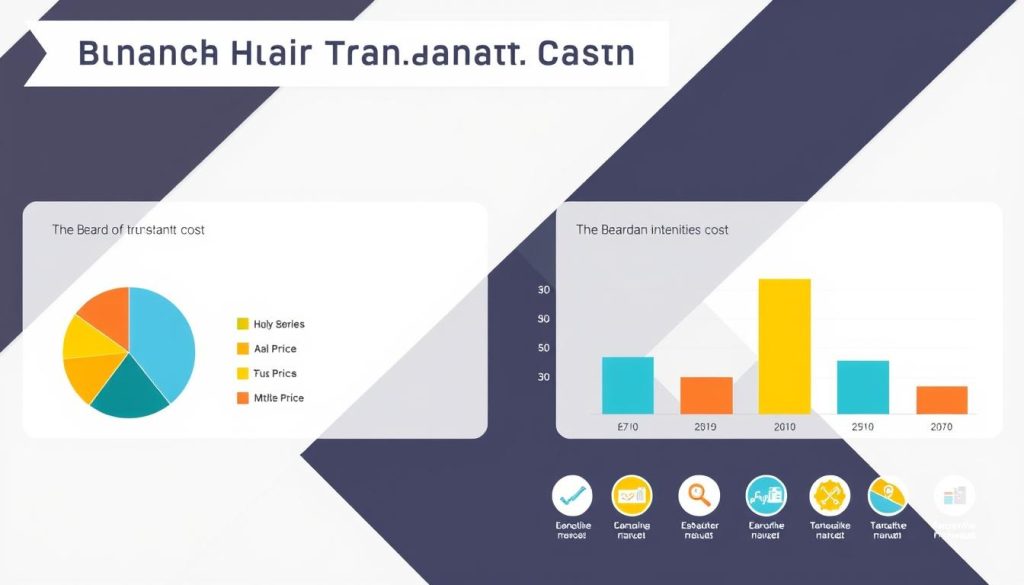
Thinking about a beard transplant? Look at these factors to understand the beard transplant cost. It’s smart to talk to different clinics. They can give you a quote that fits your needs and budget.
Comparing Beard Hair Transplants to Alternatives
Looking into ways to improve facial hair, it’s key to weigh traditional beard hair transplants against less invasive options. By comparing these methods, people can choose what fits their beauty goals and lifestyle best.
Beard Fillers
Beard fillers are a non-surgical way to boost facial hair. They use hyaluronic acid or similar materials to make the beard look fuller. This method is fast, with little downtime, making it great for those wanting quick results. Yet, the results don’t last long, so you’ll need to get them done again often.
Microblading
Microblading is good for making sparse or patchy areas look fuller. It uses fine needles to apply pigment under the skin, mimicking natural hair. It lasts longer than fillers but still needs touch-ups and can fade based on skin and lifestyle.
Each alternative to beard hair transplants has its own benefits and drawbacks. People should think about how long the results last, how much upkeep is needed, and how natural they look. This helps decide the best method for them.
Getting advice from a beard restoration expert can help find the right fit. They can offer personalized suggestions based on your preferences.
Maintaining Your Transplanted Beard
Keeping your transplanted beard healthy and long-lasting needs regular care. Using the best practices for beard transplant maintenance boosts its look and success.
Daily Care and Maintenance
Good transplanted beard care begins with daily hygiene. After healing, gentle cleaning is key to avoid irritation. It keeps the hair follicles clean from dirt and oils. Moisturizing is also vital; it soothes the skin and keeps hair soft.
A beard oil or moisturizer tested by your surgeon is perfect. It keeps your skin hydrated without clogging pores.
Recommended Products
We’ve listed essential items for your transplanted beard care. These products help keep your beard healthy and looking great:
- Beard Wash: Mild and hydrating to avoid skin irritation
- Beard Oil: Non-comedogenic oils like Argan or Jojoba oil help moisturize and nourish the skin
- Beard Balm: Aids in styling while providing nutrients to the beard hair
- Soft Bristle Beard Brush: Stimulates blood flow and helps distribute natural oils throughout the beard
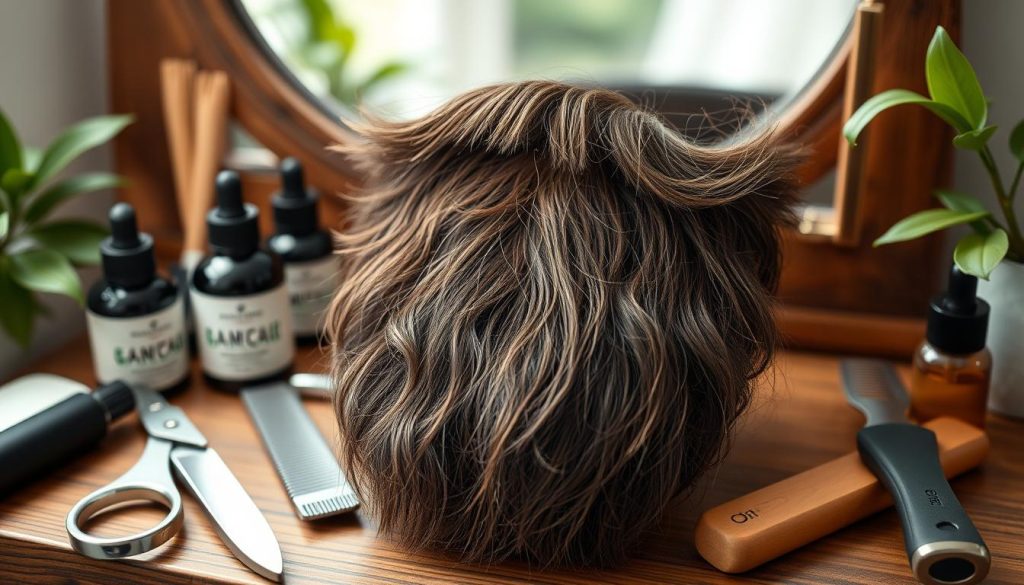
Using these products daily keeps your transplanted beard healthy and vibrant. Each item is crucial for the skin’s health and your beard’s shine and strength.
| Product Type | Use | Benefits |
|---|---|---|
| Beard Wash | Daily Cleansing | Gentle on Skin, Reduces Irritation |
| Beard Oil | Daily Moisturizing | Nourishes Skin & Hair, Non-Comedogenic |
| Beard Balm | Styling Assistance | Provides Hold, Supplies Nutrients |
| Soft Bristle Brush | Regular Grooming | Increases Blood Flow, Enhances Oil Distribution |
In conclusion, caring for a transplanted beard is simple with the right tools and methods. By following these tips, your beard will be a key part of your look and confidence.
Beard Hair Transplant Success Stories
This section shares amazing beard hair transplant results and patient satisfaction stories. It shows how new facial hair restoration techs change lives. You’ll hear from people who’ve seen big changes, boosting their looks and confidence.
Real-Life Transformations
Beard hair transplants are shown in before-and-after photos. These changes do more than just look good. They also make people feel better about themselves.
Testimonials from Patients
What patients say about their experiences is the most real. Here are some stories from those who’ve had the procedure:
I’ve gained not only a fuller beard but also a new-found confidence that I didn’t know was missing. Thank you for transforming my life!
After the transplant, the beard hair transplant results were better than I hoped. It looks natural, and it’s easy to keep up.
These stories highlight the personal and social gains of getting a beard hair transplant. They show how well the procedure works from the patient’s point of view.
| Before Transplant | After Transplant | Patient Feedback |
|---|---|---|
| Patchy beard growth | Full, dense beard | Exceptionally pleased with the cosmetic enhancement. |
| Uneven beard lines | Well-defined jawline and beard shape | Life-changing results, leading to increased self-esteem. |
Finding a Qualified Surgeon
Choosing a qualified beard transplant surgeon is key when thinking about a beard hair transplant. This choice impacts your beard’s look and the procedure’s success and safety. Knowing what to look for and what to ask is crucial.
What to Look For
It’s important to find a surgeon who specializes in beard restorations. Make sure they are certified and have lots of experience in beard transplants. Look for surgeons certified by groups like the American Board of Hair Restoration Surgery. A guide on qualifications can help you understand what to look for.
Reviewing before and after photos of previous patients can give you an idea of the surgeon’s skills. A thorough consultation should cover what to expect and any possible risks.
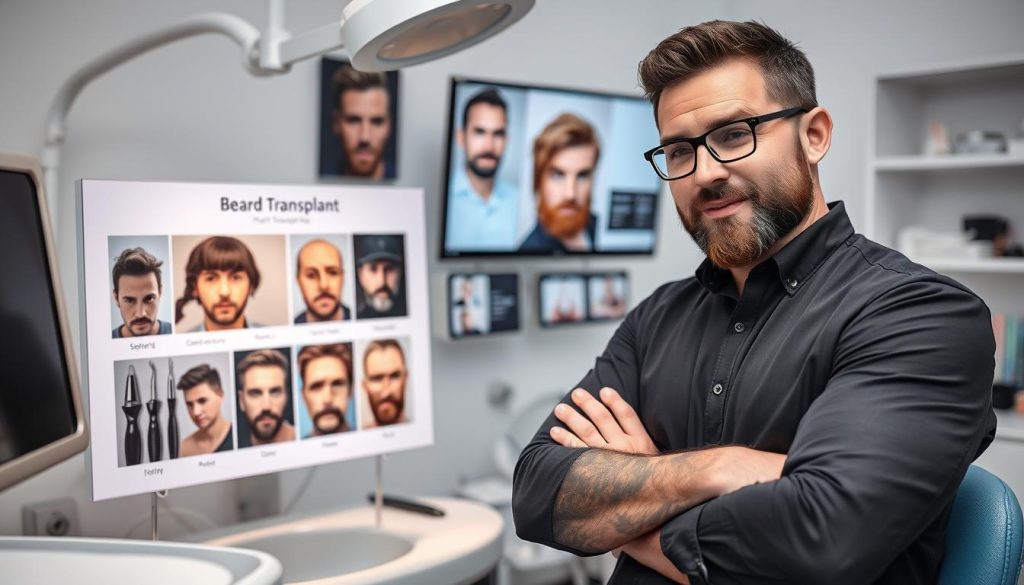
Questions to Ask
Before choosing your surgeon for beard restoration, ask specific questions. Find out about their experience with beard transplants and their preferred techniques. Ask how many sessions you’ll need and the total cost.
It’s also important to know about aftercare and follow-up visits. Ask about any complications they’ve faced and how they were handled. Don’t forget to ask about financing options if cost is a concern.
| Question | Details |
|---|---|
| Experience with Beard Transplants | Details on the number of beard transplants performed |
| Technique Preference | Information on whether they use FUE, DHI, or other methods |
| Session Count and Costs | Estimated sessions required and a breakdown of costs |
| Handling Complications | Examples of past complications and resolutions |
| Payment Options | Description of financing plans or payment options available |
By carefully checking qualifications and asking the right questions, you can find a surgeon for a safe and successful beard transplant. This sets the stage for great results.
Aftercare Tips for Your New Beard
Taking good care of your new beard is key to its growth and look. Knowing how to caring for your new beard helps it heal fast and grow well. This care is crucial for the best results.
Essential Aftercare Steps
After your beard transplant, follow important aftercare steps. These steps help your beard heal and grow better. Here are some key practices:
- Keep the transplanted area clean and hygienic to prevent any infections.
- Avoid touching or scratching the new beard area to ensure the grafts are not dislodged.
- Apply soothing lotions or sprays as recommended by your surgeon to alleviate any itchiness or irritation.
- Avoid exposure to direct sunlight, and use a protective scarf or hat if going outdoors is necessary.
Lifestyle Adjustments
Changing your lifestyle a bit after the transplant can help a lot. Here are some tips:
- Leverage a gentle shampoo for the first few washes and gradually transition to regular products as advised by your health care provider.
- Pause strenuous activities and exercises for at least a week to avoid excessive sweating and tugging at the facial area.
- Opt for a healthy diet rich in vitamins and minerals which foster hair growth, such as Vitamin C, Vitamin B, iron, and zinc.
- Monitor and manage stress through techniques like meditation or yoga as stress can negatively affect hair growth.
Here’s a visual guide to beard transplant aftercare steps:
| Activity | Recommended Action | Duration |
|---|---|---|
| Cleaning | Use prescribed lotions, avoid harsh chemicals | First 1-2 weeks |
| Moisturizing | Apply gentle, non-comedogenic moisturizers | Until complete healing |
| Exposure to Sun | Avoid direct sunlight, use protective gear | First 3 months |
| Diet | Incorporate nutrient-rich foods in meals | Ongoing |
Future of Beard Hair Transplants
The world of beauty medicine is always changing, especially in beard hair transplants. People want to look good, so they’re looking for better ways to restore their beards.
Innovations in Hair Restoration
New tech is making beard hair transplants better. Innovations in beard hair transplant include AI that helps place hair perfectly. This tech makes the process smoother and cuts down on recovery time.
Trends to Watch in 2023
In 2023, future trends in beard restoration will focus on custom plans. These plans use special tools to match treatments to each person’s needs. This approach aims to make treatments more effective and satisfying.
There’s also a growing push for eco-friendly practices in beauty treatments. Doctors are now using less waste and biodegradable materials. This shows a big step towards caring for our planet in medical fields.
These new ideas and trends will make beard transplants better and more in line with today’s values. They promise to improve results and meet the needs of today’s consumers.
Frequently Asked Questions (FAQ)
Understanding beard hair transplant procedures starts with answering common questions and concerns. We aim to clear up some of the most asked questions and debunk myths. This FAQ is here to help you understand if this procedure is right for you.
Common Queries Addressed
People often wonder how long the procedure takes and how long the results last. They also ask about recovery, who’s a good candidate, and how to care for a transplanted beard. These questions are important to answer clearly to help you make an informed decision.
Myths vs. Facts
We work to separate myths from facts about beard transplants. For example, it’s a myth that you’ll have a full beard right away. In reality, it takes time to see the full results. It’s important to know the truth to set realistic expectations and understand the treatment’s effectiveness.
FAQ
Q: What is a Beard Hair Transplant?
A: A beard hair transplant moves hair from the scalp to your face. It makes your beard fuller or covers thin spots.
Q: What are the Benefits of Beard Hair Transplants?
A: They make your face look better and your beard line clearer. They can also boost your confidence.
Q: Who is a Good Candidate for a Beard Hair Transplant?
A: You’re a good candidate if you have enough donor hair and are healthy. Your age, skin, and hair type also matter.
Q: What Techniques are Used in Beard Hair Transplants?
A: Follicular Unit Extraction (FUE) and Direct Hair Implantation (DHI) are common. They differ in scarring and healing.
Q: What is the Procedure for a Beard Hair Transplant?
A: It starts with a consultation. Then, hair follicles are moved to your beard for a natural look.
Q: What is the Recovery Timeline After a Beard Hair Transplant?
A: Recovery time varies. Right after, you’ll manage pain and swelling. Long-term care keeps the hair healthy.
Q: Are There Any Side Effects or Risks with Beard Hair Transplants?
A: Yes, you might see redness, itching, and swelling. Infections or bad hair growth are rare. Choosing a skilled surgeon helps avoid these risks.
Q: How Much Does a Beard Hair Transplant Cost?
A: Prices in the U.S. vary. They depend on how much hair you need, the method, and the surgeon’s skill.
Q: How do Beard Hair Transplants Compare to Alternatives Like Fillers or Microblading?
A: Transplants are permanent, while fillers and microblading are temporary. Your choice depends on what you need and want.
Q: How Should I Maintain My Transplanted Beard?
A: Clean and moisturize it daily. Use products your surgeon recommends to keep it looking good.
Q: Where Can I Find Real-Life Success Stories of Beard Hair Transplants?
A: Look on clinics’ websites, social media, and forums. They share success stories and patient feedback.
Q: How Do I Find a Qualified Surgeon for a Beard Hair Transplant?
A: Check their qualifications, experience, and reviews. Ask questions during your consultation to find the right surgeon.
Q: What Aftercare Tips Should I Follow After Getting a Beard Hair Transplant?
A: Follow your surgeon’s aftercare advice. This includes important steps and lifestyle changes for healing and transplant longevity.
Q: What are the Innovations and Trends in Beard Hair Transplants?
A: New tech and growth factor therapies aim to improve results. They also aim to reduce recovery time and side effects.
Q: Can You Address Some Common Myths About Beard Hair Transplants?
A: One myth is that results look fake. But, skilled surgeons make them natural. Another myth is that results are immediate. But, it takes months for full growth.













